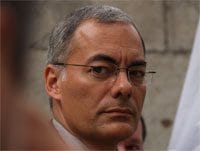The Vice-President of the Regional Council responded to questions from Nice Première concerning the extreme unsanitary and unsafe conditions in a city of Nice that he knows well, having been born there.
Mr. Patrick Allemand, how do you assess the unsanitary conditions of some buildings in Nice?
From September 1st, I alerted the Senator Mayor and the Prefect to the potential danger of certain buildings in Nice. The information I had led me to do so.
Madame ESTROSI talks about Old Nice, I don’t have specific information on that. For our part, we have identified 3 areas that represent the periphery of the SNCF station. To the east of the station, Rue Miron, Lamartine. To the south, Rue d’Italie, Rue d’Angleterre. To the north Rue Reine Jeanne and surroundings.
But the response that J. PEYRAT gave me is even more worrying. The control visits are every five years! A lot can happen in 5 years in furnished apartments. Out of 209 establishments, 57 remain unchecked. What is alarming is the rate of unfavorable opinions given by the safety commission: 13 out of 22 in 2004, 34 out of 62 in 2005, meaning 47 furnished apartments do not meet safety conditions in Nice. It’s enormous!
What would be the solutions to prevent the tragedies that occurred in Paris?
There are not 36 solutions. We need to reclaim the city center and entrust the management of these buildings to social housing providers. It’s in progress. But the political responsibility is having let the situation get to this point.
In some cases, I recommend immediate relocation with a declaration of danger issued. It concerns people’s safety.
Can you tell us about 2 rue de Villeneuve?
The situation at 2 rue de Villeneuve represents what is most distressing and explosive in the city. What we saw in this building is unspeakable. The staircase is made of wood, mailboxes smashed, exposed electrical wires, ceilings have collapsed, partitions overlooking hallways are torn open, the front doors no longer close. Even in the worst places, we had not seen this.
And the worst thing is that the city of Nice is a co-owner of this building. We are not dealing with a slumlord, but… with the city of Nice.
As a co-owner, it cannot ignore this situation. It should have made emergency repairs, even if it means partially recharging other co-owners.
Its political and moral responsibility is committed. If there were a problem tomorrow, its criminal responsibility would likely be engaged.
And the disagreement with Mrs. Estrosi?
I don’t have a disagreement with Madame ESTROSI. But given the tone on which she took the matter, I advise her to act quickly as I do not intend to let it go. And I told her so.
Regarding the OPAM, you reacted to the closure of offices following the assault on an agent. Why?
I had to do it by strongly condemning the assault suffered by the Director of Housing of the OPAM and the subsequent assaults. The OPAM staff works in difficult conditions. They are exposed to the anger of tenants caused by decisions of which they are merely the executors.
This misstep shows that the situation has become explosive in Nice.
This normalization of violence in certain neighborhoods of the city goes beyond the problem of squats. We are paying today for past mistakes and the lack of prompt response from public authorities to maintenance-related requests that remain unanswered for weeks causing general exasperation.
But closing the headquarters of the OPAM and the agencies was a bad response. Public service must remain present in the housing estates. These closures only reinforce the sense of abandonment that is so prevalent among the residents of these neighborhoods.
Regarding security, did you watch the show “Emergency Calls” on TF1 and what do you think?
Like many people in Nice, I believe, I was very shocked by the show “Emergency Calls” broadcast on TF1.
It’s not a question of minimizing the security problem in Nice. I have intervened several times to demand more personnel on the outskirts of Nice. Because the people who live there have the same right to security and dignity as the residents of residential neighborhoods and those in the city center. And because the first image tourists arriving in Nice by car have is that of the Moulins or the Pont Garigliano.
But we must not accept such a fantastical treatment of the city of Nice, which would be according to TF1 a “non-place zone”. At this level, we are in the untruth. For me, this program has seriously damaged the image of a city that partly lives from tourism, and has stigmatized entire neighborhoods with humiliating comments. This is very regrettable because we have no right to play like this with the fears and with the image of a city that has already suffered too much from the coarse representations that have been given of it.
What would be your solutions to improve security in Nice?
I have set up a working group on this issue. We have worked a lot, listened a lot, to policemen, social workers, educators. I now have a very clear idea of what needs to be proposed.
I believe that the city, without encroaching on the “turf” of the national police, must be much more involved than currently, that a real “on-the-ground” contract must emerge, with a precise redefinition of everyone’s missions, at the end of real negotiation, well beyond the current formal contracts that give a good conscience to all signatories without getting to the heart of the matter.
But I will not say more for now.
And finally, what are Patrick Allemand’s projects for Nice in the coming months?
My projects are numerous… But revealing them now would deprive them of all strength in the debate that will be established in the city in the months to come. So a little patience…


